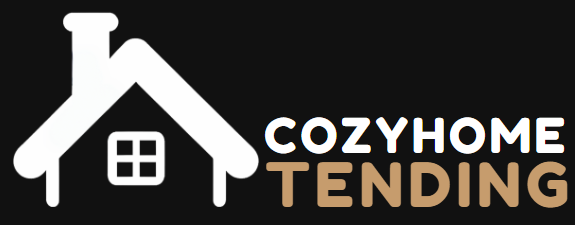Are you struggling to keep your chimney clean and well-maintained? An unclean chimney can lead to potential fire hazards, health risks, and decreased fireplace efficiency. This article will guide you through simple techniques and essentials needed for an effective chimney cleaning process.
Ready to make your fireplace safer and more efficient? Let’s dive in!
Key Takeaways
- Regular chimney cleaning is important to prevent fires, reduce health risks, and improve fireplace efficiency.
- Essential tools for chimney cleaning include a chimney brush, drop cloth or tarp, chimney sweep rods, and protective gear.
- Chimney cleaning involves brushing the flue from top to bottom, cleaning the firebox and smoke shelf, and properly disposing of debris.
- Safety precautions include hiring a professional chimney sweep for complex cleanings, proper disposal of debris, and scheduling routine inspections.
The Importance of Regular Chimney Cleaning
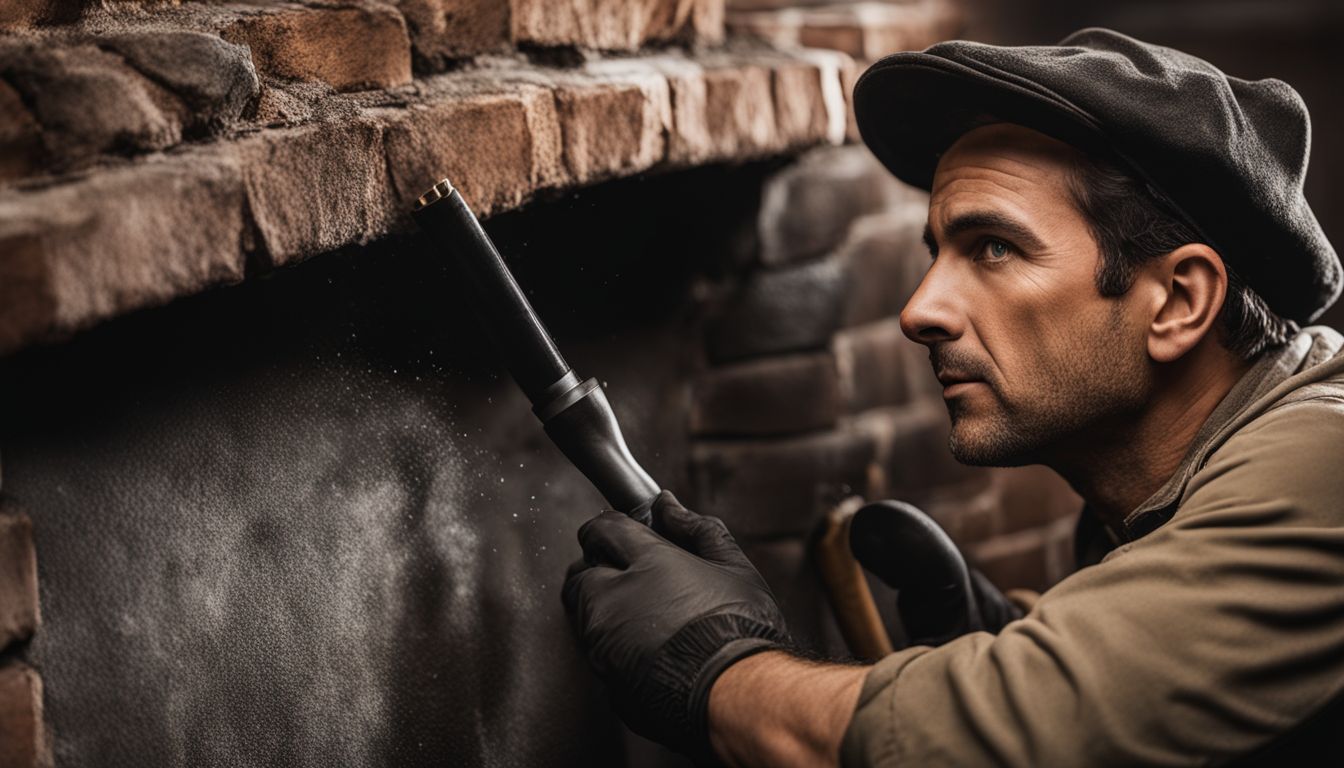 A professional chimney sweep cleaning and inspecting a chimney using specialized tools.
A professional chimney sweep cleaning and inspecting a chimney using specialized tools.
Regular chimney cleaning is essential for preventing chimney fires, minimizing health hazards, and improving fireplace efficiency.
Over time, chimneys accumulate creosote, a highly flammable residue from burning wood, which can ignite and cause chimney fires. Cleaning helps eliminate this risk. Additionally, it removes obstructions like bird nests or debris, ensuring proper airflow, reducing the risk of carbon monoxide buildup, and improving air quality.
Regular maintenance also enhances the overall efficiency of your fireplace or wood stove, as a clean chimney allows for better heat distribution. By scheduling annual inspections and cleanings, homeowners can extend the life of their chimneys, prevent costly repairs, and ensure a safe, warm, and efficient home environment.
Preventing chimney fires
Chimney fires can cause great harm. They start when soot and creosote build up in your chimney. Creosote is a sticky, oily substance that can easily catch fire. Keeping your chimney clean lowers the risk of a fire.
You should clean it once or twice a year. If you burn wood often, you may need to clean more often. Always check for soot or creosote before starting a fire. Use tools like brushes and rods to scrape them off the walls of the chimney flue.
Minimizing health hazards
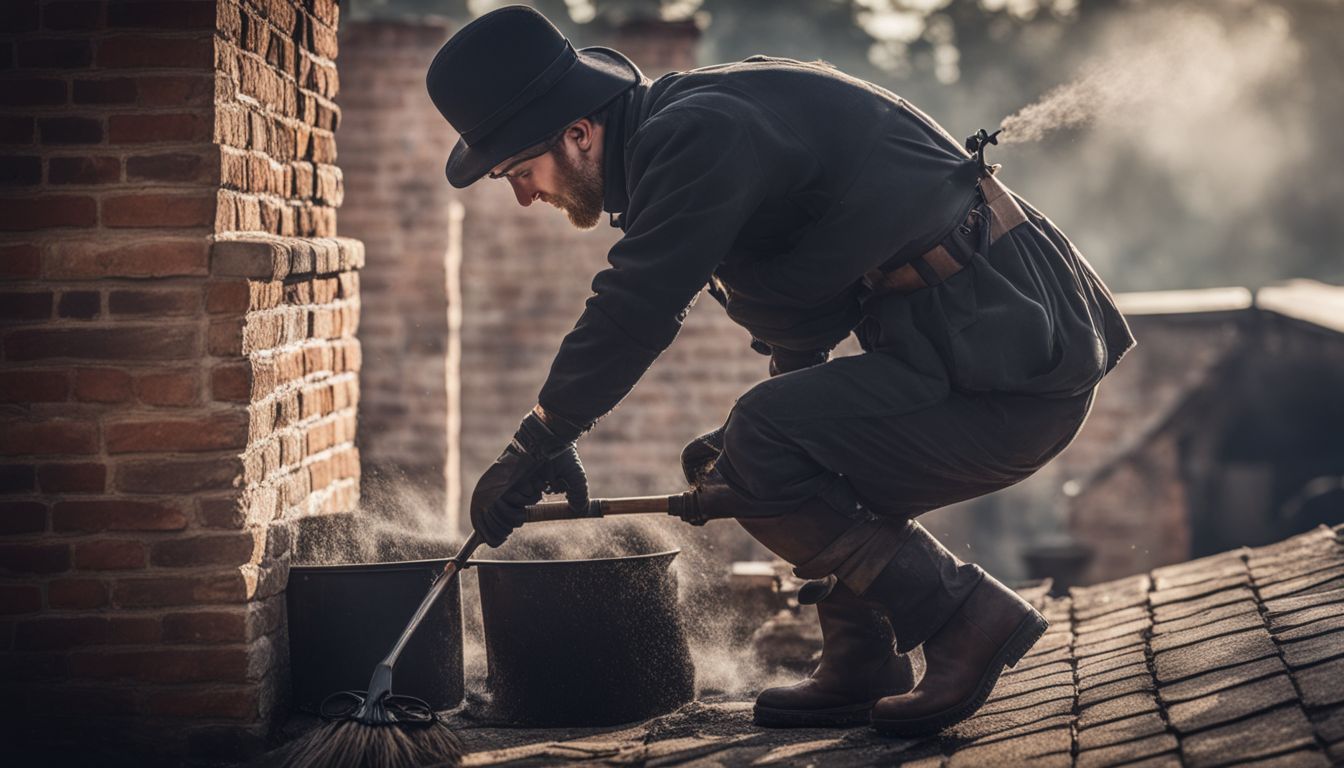
Dirt and soot can be bad for your health. Regular chimney cleaning takes this away. It makes sure the air in your home is clean to breathe. Having a dirty chimney can cause problems like allergies and lung issues.
A well-cleaned chimney is good for you and your family’s health. If not cleaned, harmful things like creosote can build up inside it. Creosote is a tar-like substance that comes from burning wood.
Over time, it sticks to the walls of your chimney flue. Too much creosote can make you sick or start a fire if not removed on time with proper tools like a Chimney brush.
Improving fireplace efficiency
A clean chimney makes your fireplace work better. It pulls more air in. This means that the fire burns hotter and more even. Also, less smoke gets into the house. So less soot builds up on your walls and ceiling.
Clean chimneys also use less wood or gas to heat a room. Cleaning out all the ash and creosote helps, too. The firebox has more space for bigger, hotter fires. And don’t forget about safety! A good fireplace sends sparks straight up the flue instead of onto your rug.
Essential Tools and Materials for Chimney Cleaning
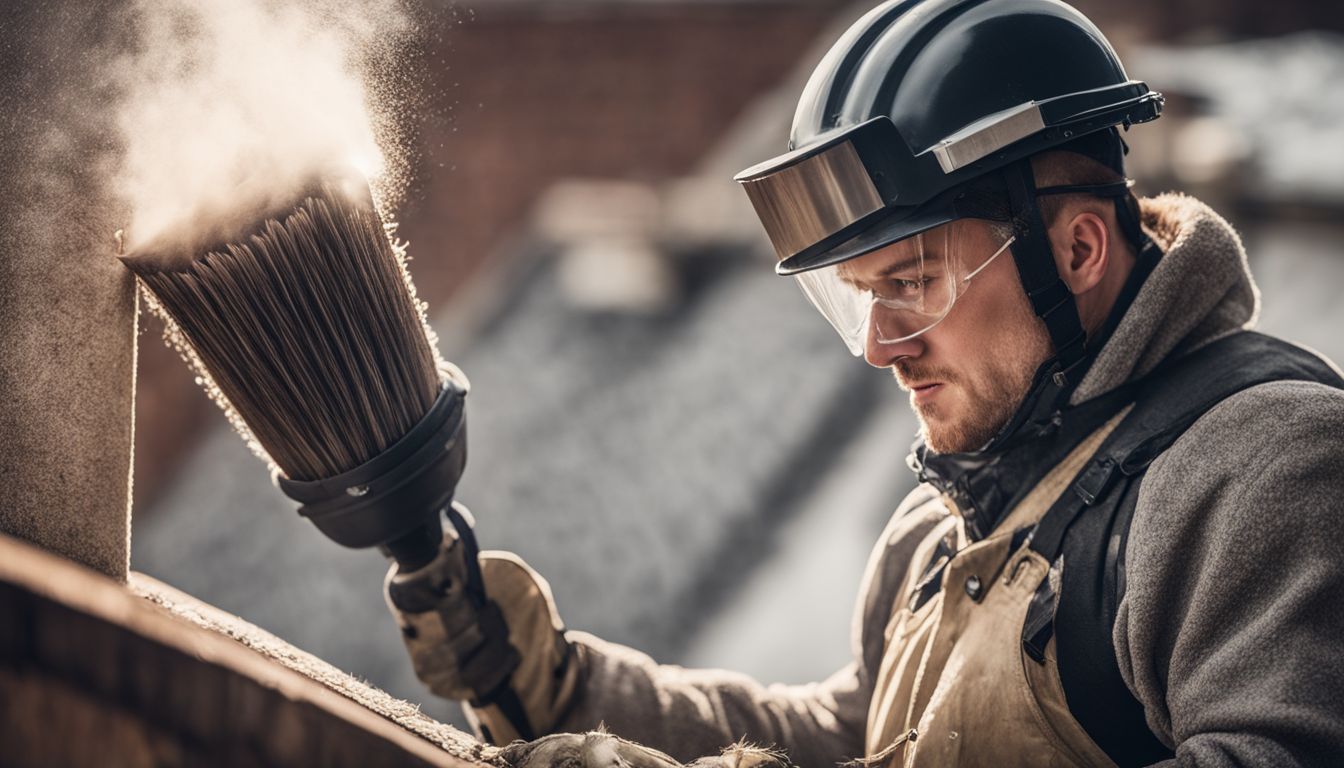
To effectively clean a chimney, you will need the following tools and materials: a chimney brush, drop cloth or tarp, chimney sweep rods, and protective gear.
Chimney brush
To effectively clean your chimney, you’ll need a chimney brush. This tool is specifically designed to scrub away creosote and soot buildup inside the flue. It typically consists of sturdy bristles attached to a long handle, allowing you to reach deep into the chimney.
When choosing a chimney brush, make sure it’s the appropriate size for your flue. By using a chimney brush regularly, you can prevent blockages and improve the safety and efficiency of your fireplace.
Drop cloth or tarp
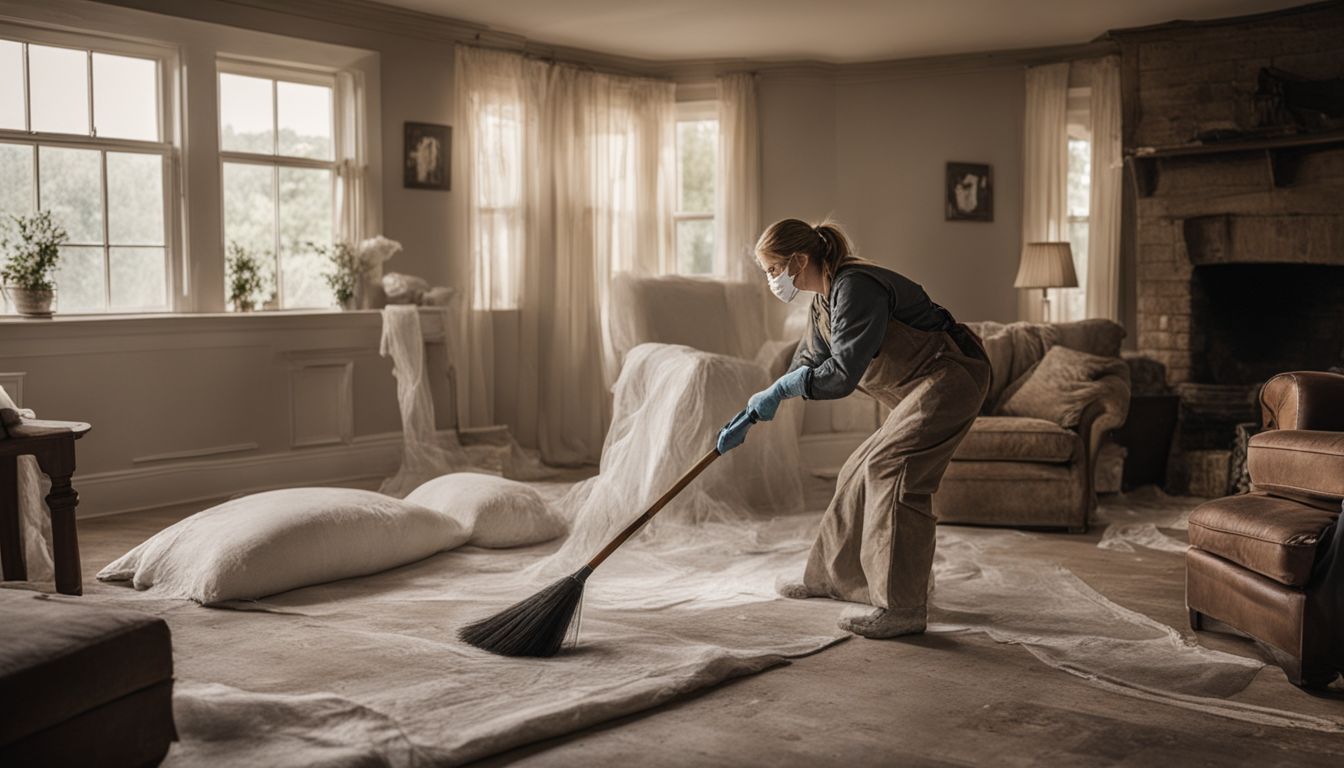
To protect your home from dirt and debris while chimney cleaning, it’s important to use a drop cloth or tarp. These protective materials can be placed on the floor and furniture near the fireplace to catch any soot or ashes that may fall during the cleaning process.
This will make cleanup much easier and prevent stains or damage to your belongings. By using a drop cloth or tarp, you can ensure that your chimney cleaning is not only effective but also mess-free.
Chimney sweep rods
To effectively clean your chimney, you will need chimney sweep rods. These long and flexible rods are essential for reaching the entire length of the flue. They have threaded ends that allow you to attach different brush heads, making it easier to remove soot and debris from the chimney walls.
When using chimney sweep rods, make sure to work from top to bottom, ensuring a thorough cleaning. It is important to invest in quality rods that are sturdy and durable, as they will be able to withstand the demands of chimney cleaning.
Protective gear
When it comes to chimney cleaning, wearing protective gear is crucial for your safety. Make sure to wear a sturdy pair of gloves to protect your hands from sharp debris and soot. Also, wear safety goggles or glasses to shield your eyes from any particles that may fly up during the cleaning process.
Additionally, consider wearing a dust mask or respirator to avoid inhaling harmful substances like creosote and soot. By using the right protective gear, you can ensure that you stay safe while maintaining your chimney.
Preparing for Cleaning
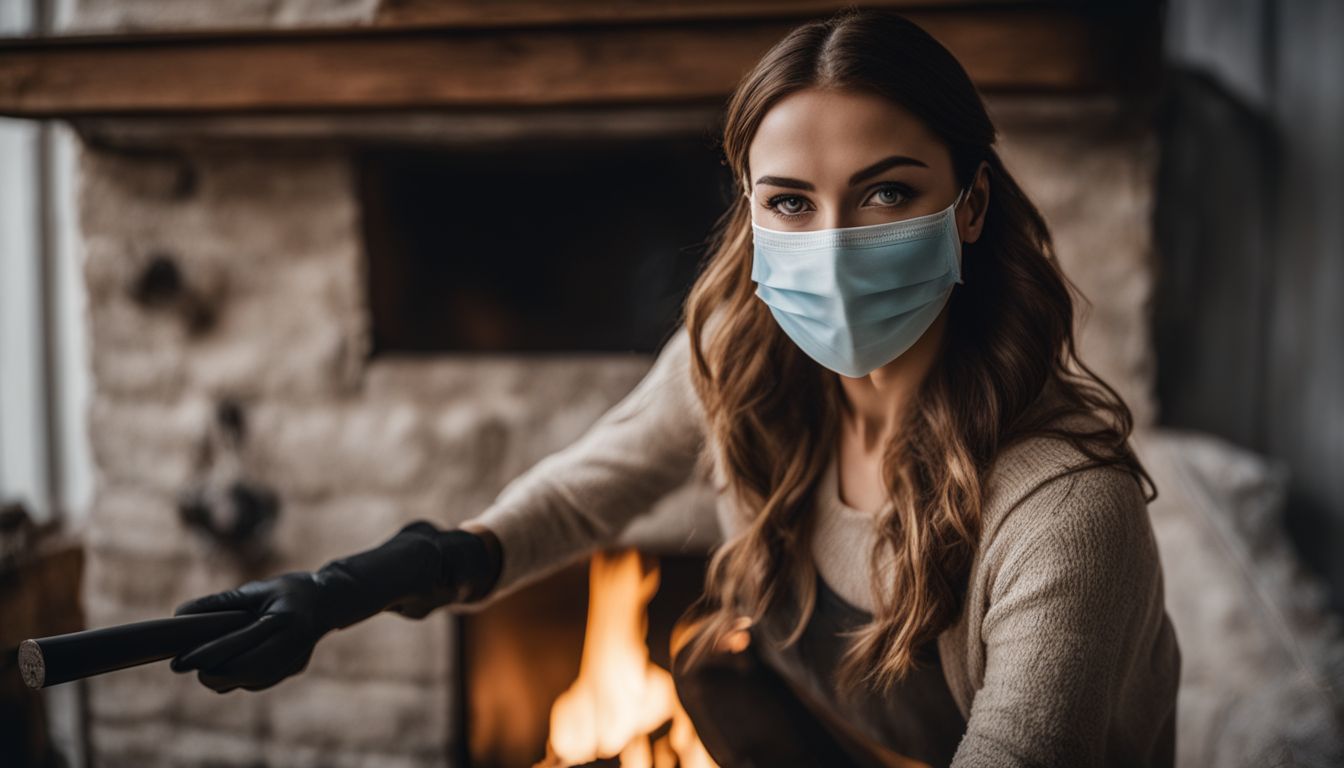
To prepare for cleaning, secure the area by removing any furniture or objects near the fireplace and covering the surrounding surfaces with a drop cloth or tarp. Set up your chimney brush and sweep rods, making sure they are securely attached.
Additionally, put on protective gear such as gloves and safety goggles before starting the cleaning process.
Securing the area
Before you start cleaning your chimney, it’s important to secure the area to ensure safety. Remove any furniture or objects near the fireplace that could be in the way. Cover nearby surfaces with a drop cloth or tarp to protect them from debris and soot.
Make sure all windows and doors are closed to prevent dust from spreading throughout your home. By taking these steps, you can create a clean and safe environment for chimney cleaning without worrying about damaging your belongings or causing a mess in your house.
Setting up equipment
To prepare for chimney cleaning, you’ll need a few essential tools and materials. First, you’ll need a chimney brush to scrub away the buildup inside the flue. Next, lay down a drop cloth or tarp to protect your floors from any mess.
Chimney sweep rods will help you reach all areas of the flue, so be sure to have those on hand as well. Lastly, don’t forget to wear protective gear like gloves and goggles for your safety.
With these items ready, you’ll be all set to start cleaning your chimney!
Protecting interior surfaces
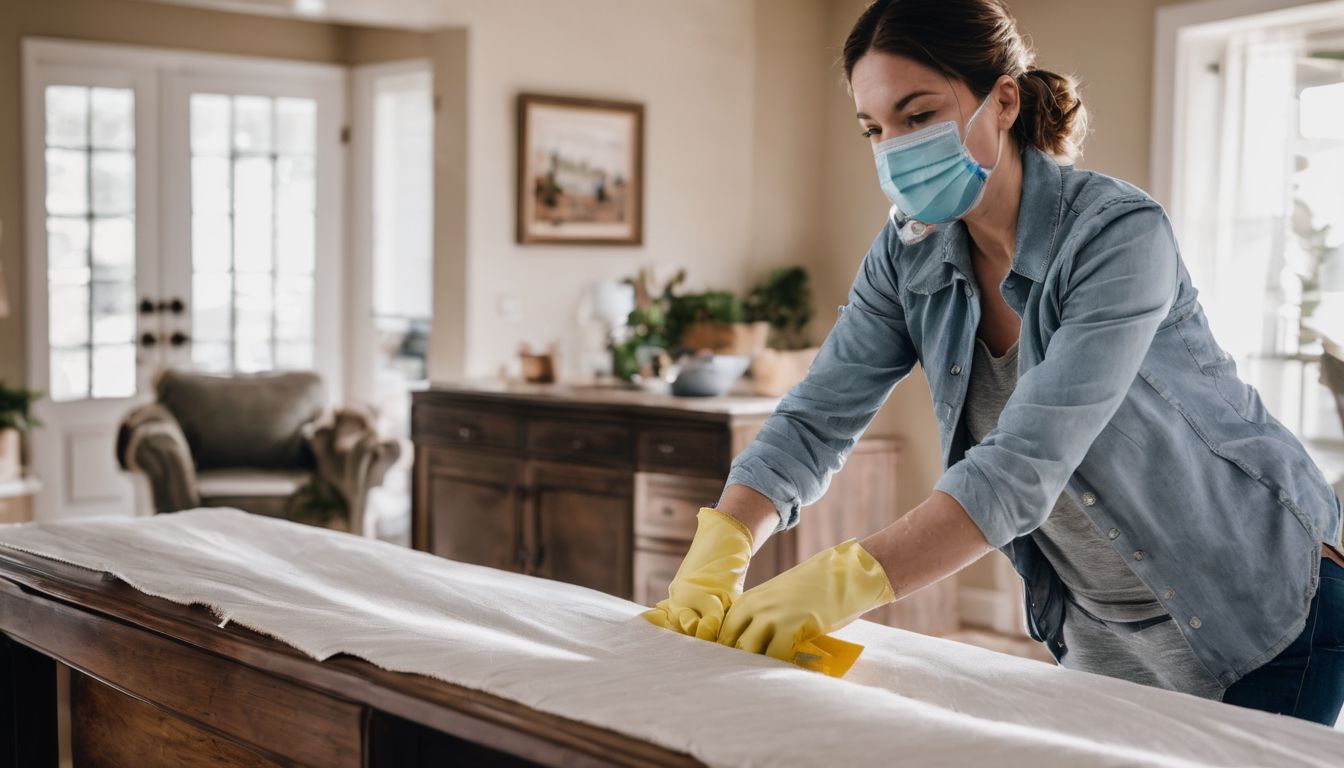
To protect the interior surfaces of your home during chimney cleaning, it’s important to take certain precautions. Start by covering nearby furniture and flooring with a drop cloth or tarp.
This will prevent debris or soot from getting onto your belongings and making a mess. Additionally, use masking tape to secure the edges of the drop cloth for extra protection.
By taking these simple steps, you can ensure that your home stays clean while you clean your chimney.
Cleaning Process
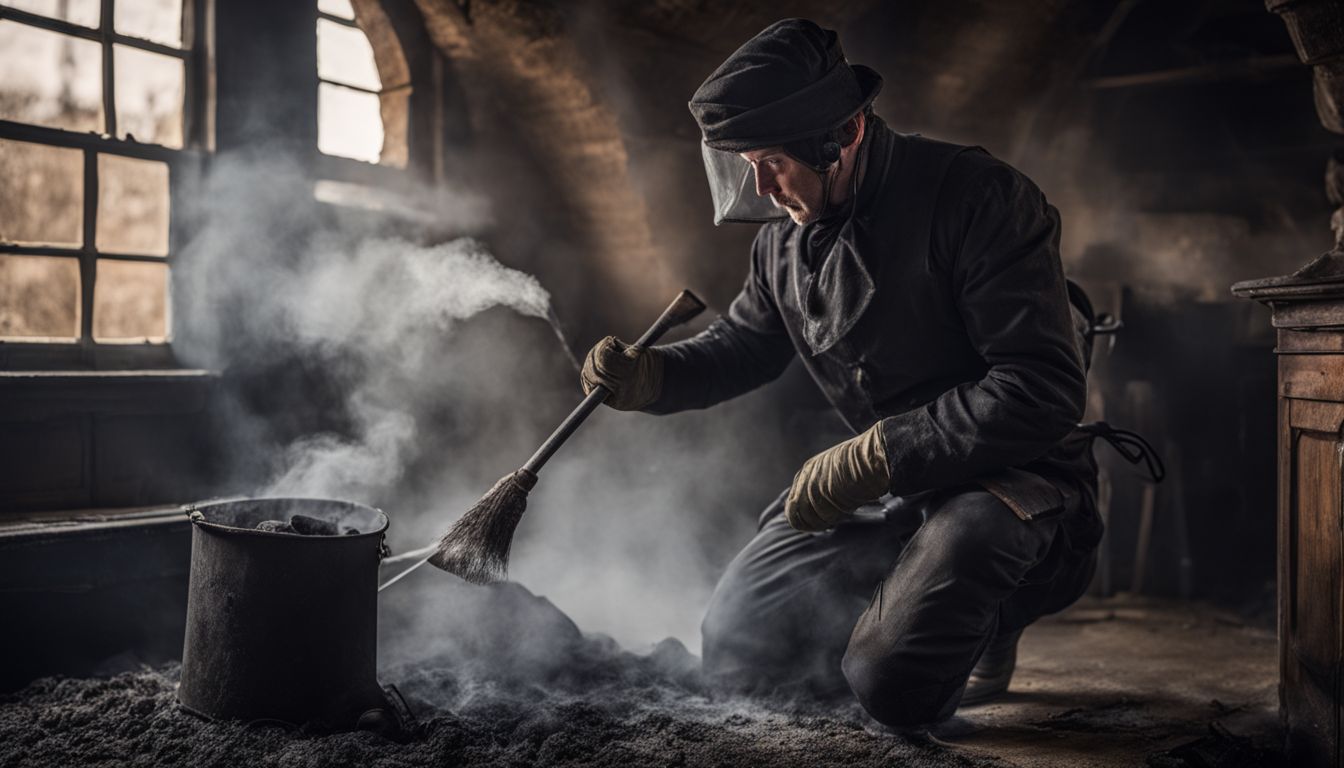
To clean your chimney, start by brushing the flue from top to bottom using a chimney brush attached to sweep rods. Next, clean the firebox and smoke shelf, removing any debris and soot.
Finally, dispose of the collected debris properly and consider routine inspections for continued chimney maintenance.
Brushing the flue from top to bottom
To effectively clean your chimney, it’s important to brush the flue from top to bottom. This helps remove built-up soot and debris that can cause blockages or pose a fire hazard. Start by attaching the chimney brush to the end of a chimney sweep rod.
Carefully insert the brush into the flue and gently scrub the walls as you pull it down towards you. Repeat this process several times until all areas of the flue have been thoroughly cleaned.
Be sure to wear protective gear and cover nearby surfaces with drop cloths or tarps to minimize mess.
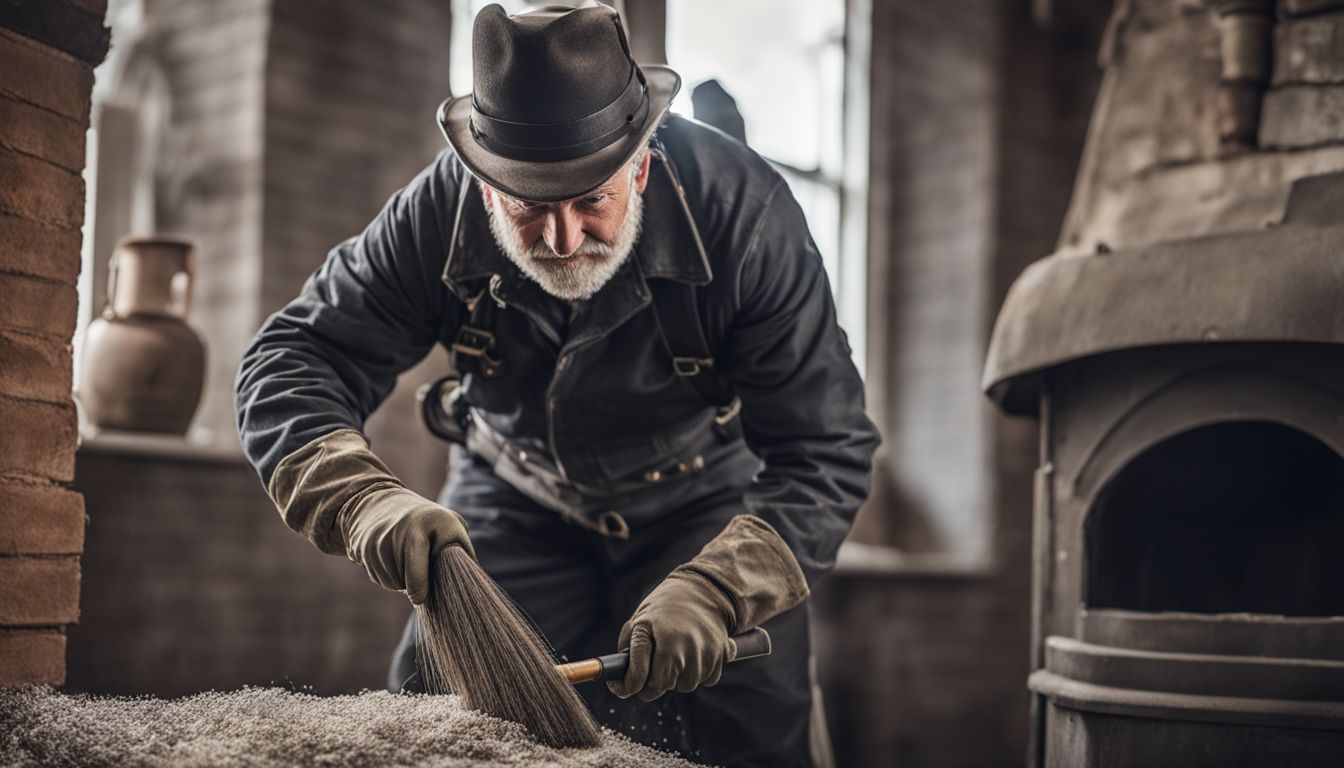
Cleaning the firebox and smoke shelf
To properly clean the firebox and smoke shelf of your chimney, you’ll need a few tools. Start by removing any debris or ashes from the firebox using a small shovel or brush. Next, use a stiff wire brush to scrub the walls and floor of the firebox, getting rid of any soot or creosote buildup.
Don’t forget to clean the smoke shelf as well, using the same brush to remove any residue. Once everything is free of debris, sweep up any remaining ashes and dispose of them properly.
Keep in mind that if you’re unsure about performing this task yourself, it’s best to hire a professional chimney sweep to ensure it’s done safely and effectively.
Removing debris and soot
To effectively remove debris and soot from your chimney, start by using a chimney brush to scrub the flue from top to bottom. This will help dislodge any buildup and ensure that the smoke can flow freely through the chimney.
Don’t forget to clean the firebox and smoke shelf as well, as these areas can accumulate ash and debris over time. Use a tarp or drop cloth to protect your interior surfaces during this process.
By thoroughly clearing away debris and soot, you’ll improve your fireplace’s efficiency and reduce the risk of chimney fires.
Safety Precautions and Tips
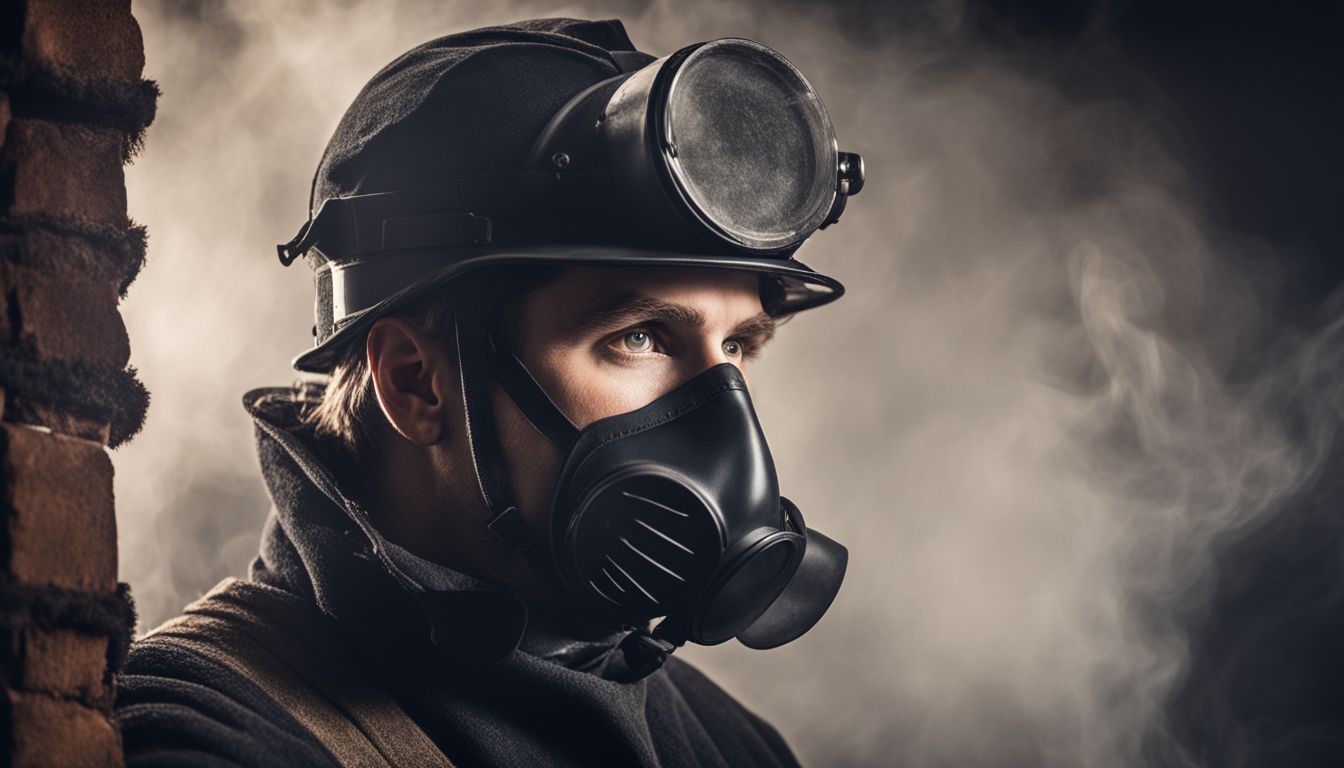
Safety should always be a top priority when it comes to chimney cleaning. From hiring a professional chimney sweep for complex cleanings to properly disposing of debris, this section will provide you with essential safety precautions and tips you need to know.
Hiring a chimney sweep for more complex cleaning
If you have a chimney that needs more complex cleaning, hiring a professional chimney sweep might be a good idea. Chimney sweeps are trained and experienced in handling tough cleaning tasks, and they can ensure that your chimney is thoroughly cleaned and free of any blockages or debris.
They have the knowledge and expertise to safely clean hard-to-reach areas of the chimney, such as the flue and smoke shelf. By hiring a chimney sweep, you can have peace of mind knowing that your chimney will be properly maintained and ready for use whenever you want to enjoy a cozy fire at home.
Proper disposal of debris
Once you have finished cleaning your chimney, it’s important to dispose of the debris properly. This will prevent any mess or potential hazards in your home. You can start by using a drop cloth or tarp to collect the debris as you clean.
Once you are done, carefully gather the cloth or tarp and place it in a sturdy garbage bag. Make sure to seal the bag tightly before disposing of it in an appropriate waste container.
Avoid throwing the debris directly into your regular trash bin, as it may contain soot and other harmful substances. By taking these simple steps, you can ensure a safe and clean environment after chimney cleaning.
Routine inspections
To keep your chimney in good condition, routine inspections are essential. Inspections help identify any potential issues before they become major problems. A professional chimney sweep can thoroughly inspect your chimney for creosote buildup, cracks, loose bricks, or other signs of damage.
They will also check the flue and fireplace components to ensure everything is functioning properly. Regular inspections give you peace of mind, knowing that your chimney is safe and functioning efficiently.
It’s recommended to schedule an inspection at least once a year to maintain the longevity and safety of your chimney.
Conclusion
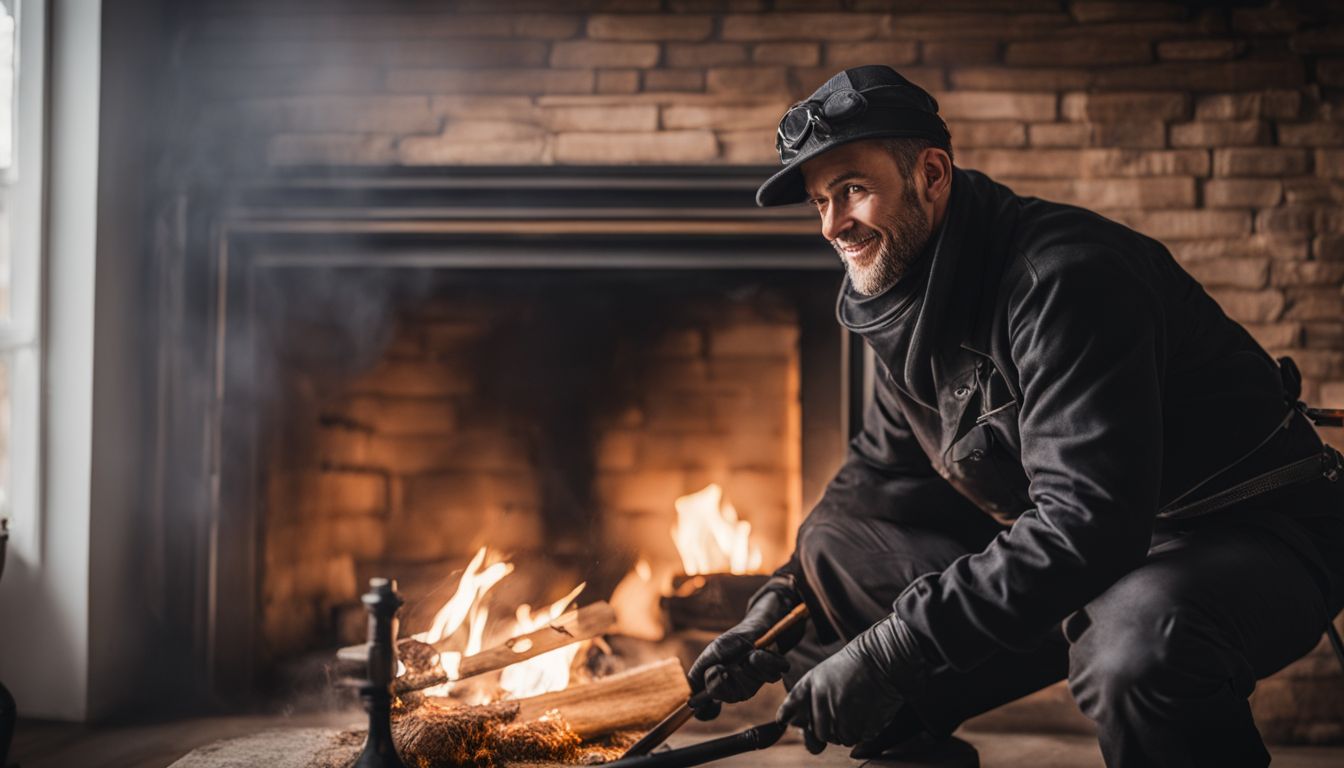
Keeping your chimney clean and well-maintained is crucial for preventing fires, minimizing health risks, and increasing the efficiency of your fireplace. By using simple techniques and essential tools like a chimney brush and protective gear, you can easily clean your chimney yourself.
However, it’s important to remember that for more complex cleaning tasks or if you’re unsure about safety precautions, it’s best to hire a professional chimney sweep. With regular inspections and routine maintenance, you can ensure the safety and longevity of your chimney.
Frequently Asked Questions
1. How often should I clean my chimney?
It is recommended to clean your chimney at least once a year to prevent creosote buildup and reduce the risk of chimney fires.
2. Can I clean my chimney myself?
While it is possible to clean your chimney yourself, it is best to hire a professional chimney sweep who has the expertise and proper equipment for thorough cleaning.
3. What are some signs that indicate my chimney needs cleaning?
Signs that your chimney may need cleaning include excessive smoke, strong odors, difficulty in starting or maintaining a fire, or visible soot or debris inside the fireplace.
4. How long does it take to clean a chimney?
The time required to clean a chimney can vary depending on its size and condition. On average, it takes around 1-2 hours for a professional chimney sweep to complete the cleaning process.
5. Why is regular chimney cleaning important?
Regular chimney cleaning is important because it helps remove flammable substances like creosote and bird nests, improves airflow for efficient combustion, reduces the risk of carbon monoxide poisoning, and extends the lifespan of your fireplace or stove.
